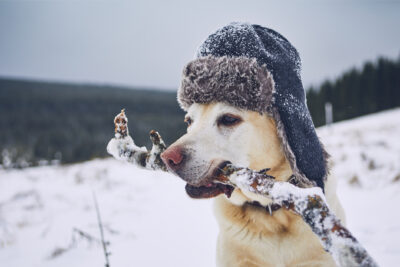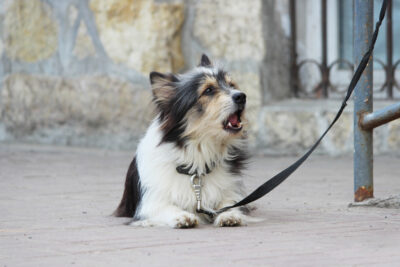Dog Eye Discharge: 7 Common Causes
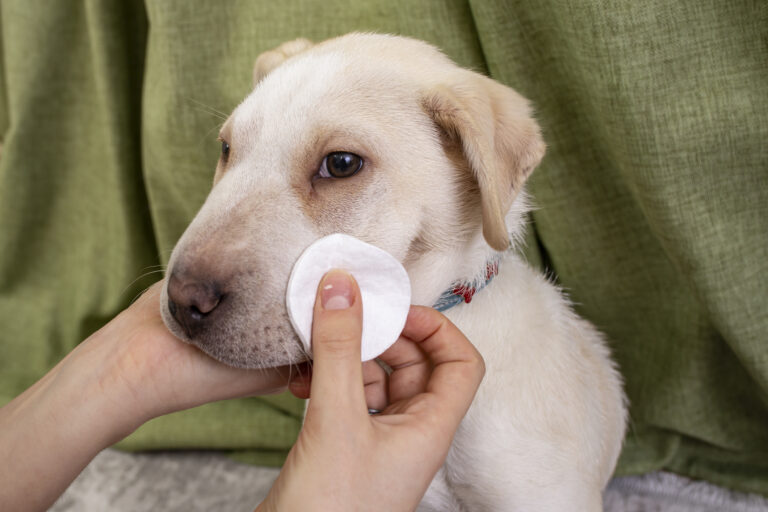
When your dog suddenly develops goopy, watery, or irritated eyes, it’s only natural to be concerned. Canine eye discharge is relatively common. While it can be completely normal in some dogs, discharge from a dog’s eye can suggest a serious condition.
Ultimately, an increase in eye discharge typically calls for a visit to your veterinarian. First, though, let’s talk about some common causes of eye discharge and what you can expect from your veterinary visit.
What Is Dog Eye Discharge?
A small amount of eye discharge can be completely normal. Tears play an important role in keeping the eye clean and lubricated, so a healthy dog’s eyes are constantly producing tears. Just like we humans occasionally wake up with “sleep” at the corners of our eyes, dogs may produce small “eye boogers” that can be completely normal.
Some dog breeds naturally produce more eye discharge than others. Brachycephalic dogs (dogs with squished faces) tend to produce more eye discharge. Common examples include Pugs, Bulldogs, Pekingese, and Shih Tzus. Other dogs, such as Cockers Spaniels and Poodles, are more likely to have blocked tear ducts, contributing to eye discharge.
When eye discharge changes in quantity or appearance, though, that can suggest a dog eye problem. There are several conditions that can cause increased or abnormal eye discharge in dogs, and it’s important to have these diagnosed quickly for prompt treatment. While increased dog eye discharge isn’t usually a cause for panic, it is a reason to call your veterinarian and schedule a veterinary visit promptly.
What Does Eye Discharge in Dogs Look Like?
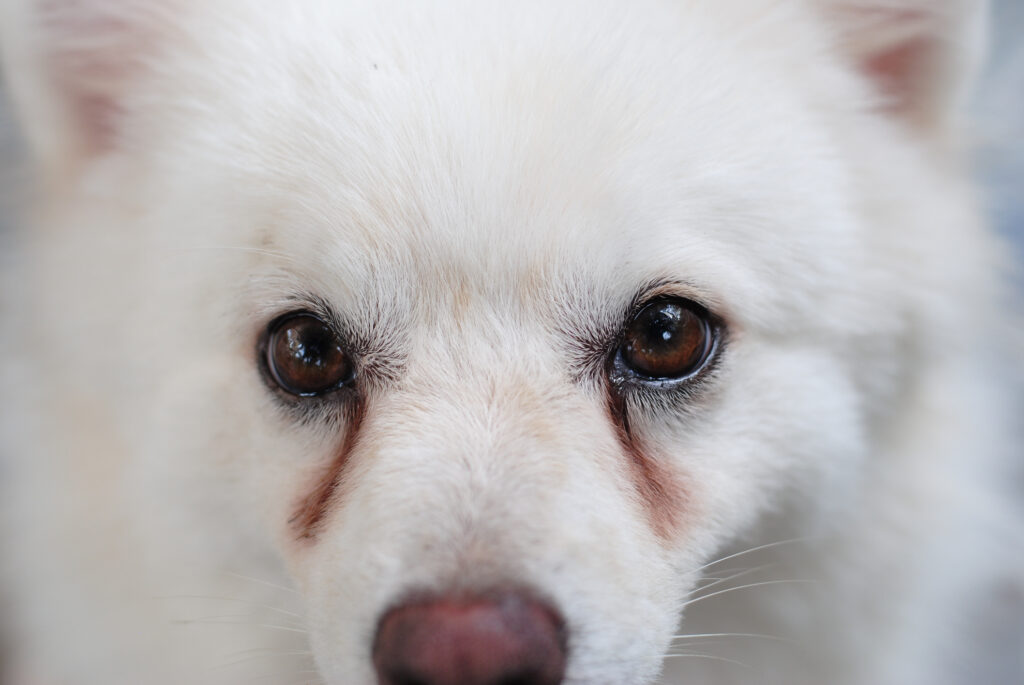
Normal dog eye discharge ranges from clear and watery to small amounts of white/tan discharge. If your dog’s eye discharge looks like how it normally appears, it is unlikely to be associated with an issue.
If your dog has white fur on their face, you may notice small amounts of brown/red tear staining near the eyes. Dog tears have pigments that turn red/brown when exposed to the air. If these tears soak into your dog’s fur and dry there, red/brown discoloration may be seen.
Abnormal eye discharge often has an abnormal color. Instead of being clear/tan, you may notice green or yellow discharge. Abnormal eye discharge is also often associated with a change in consistency: your dog’s eye discharge may be thick, stringy, goopy, or it may dry in crusts on your dog’s eyelids. Finally, abnormal eye discharge is often seen in larger amounts than normal eye discharge. Even if your dog’s eye discharge is clear and colorless, a dramatic increase in tear production could suggest a dog eye problem.
7 Causes of Dog Eye Discharge
While there are many potential causes of ocular discharge in dogs, these are seven common dog eye issues that may cause discharge.
Irritants and allergies
Just like people, dogs can have allergies. When your dog is exposed to allergies or irritants, such as smoke, fragrances, or heavy pollen, this can lead to red, watery eyes. Canine eye discharge associated with allergies is often clear and watery; if your dog has thick yellow/green discharge, allergies are an unlikely cause.
Foreign material
Dust, sand, or other debris can cause a temporary increase in eye discharge. This increased tearing is usually short-lived, because your dog’s normal tears will flush the object out of the eye. If your dog cannot flush out the debris with their own tears and the discharge persists, veterinary care may be needed.
Corneal ulcer
A corneal ulcer is a wound on the cornea (the front surface of the eye). Corneal ulcers are typically caused by trauma, such as a cat scratch, getting poked in the eye while rooting around in bushes, or getting a large piece of foreign material in the eye. Corneal ulcers are painful; in addition to eye discharge, they tend to cause redness and squinting. A corneal ulcer is an emergency. Without treatment, it can lead to loss of vision. Your veterinarian will develop a treatment plan for your dog’s ulcer.
Bacterial/viral infection
Bacteria and viruses can infect the eye, leading to an increase in eye discharge. Bacterial dog eye infections typically result in thick, yellow/green discharge that looks like pus. The discharge associated with viral dog eye infections is typically thin and watery, but it may also be green or yellow in appearance. Puppy eye discharge may be more likely to be caused by infection.
Dry eye
Dry eye (also known as keratoconjunctivitis sicca or KCS) is when a dog’s tear glands do not produce enough tears to keep the eye moist. Instead of normal, watery tears that easily wash away from the eyes, dogs with dry eye tend to have thick, goopy discharge accompanied by eye irritation. Dry eye can be treated with medication, but this medication is usually given for the rest of the dog’s life.
Eyelid abnormality
Some eyelid abnormalities are congenital, such as entropion (rolled-in eyelid), ectropion (rolled-outward eyelid), and distichiasis (a condition in which dogs develop extra eyelashes). Other eyelid abnormalities, such as eyelid tumors, may develop with age. Any abnormality of the eyelid can irritate the eye, causing eye discharge.
Blocked tear duct
Normal dogs (and people!) have a duct that drains tears from the inside margin of the eyelid to the inside of the nose. In some cases, this duct can become blocked, preventing the normal drainage of tears. A blocked tear duct can cause an increase in watery eye discharge, while also contributing to tear staining around the eyes.
Eye Discharge in Dogs Treatment
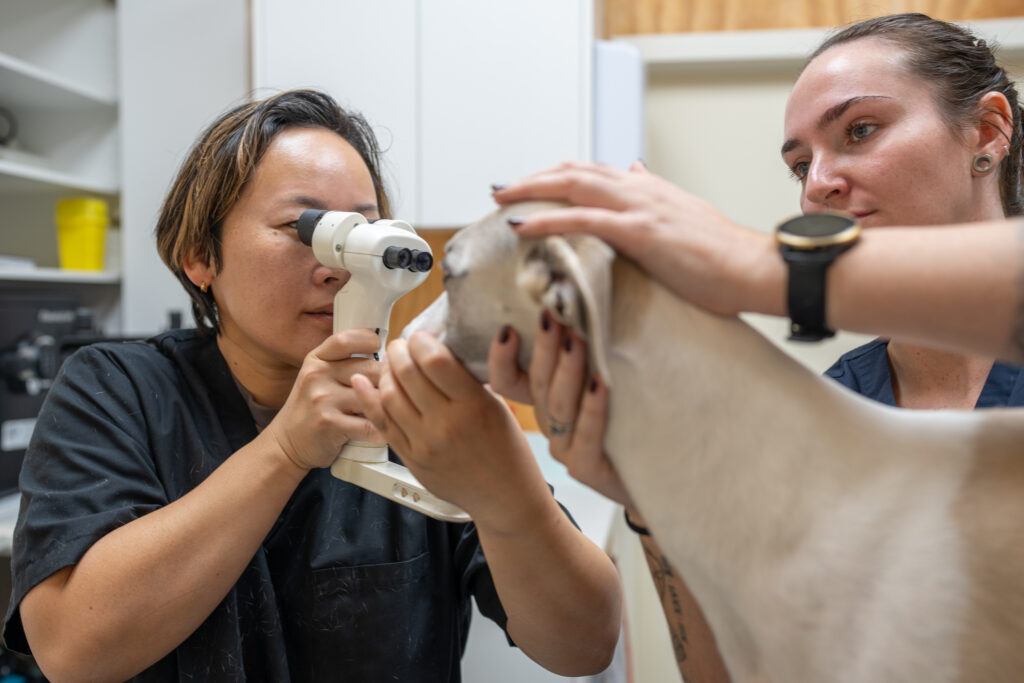
To treat dog eye discharge, your veterinarian must first find its underlying cause. In addition to performing a thorough physical exam, your veterinarian will perform an ophthalmic exam to closely examine your dog’s eye. Further testing may include a fluorescein stain (to look for corneal ulcers), tonometry (to check your dog’s eye pressure), and a Schirmer tear test (to assess your dog’s tear production). These tests will allow your veterinarian to figure out the underlying cause of your dog’s eye discharge.
Treatment may vary from simple and straightforward to more involved. If your dog has foreign material in the eye, for example, treatment may be as simple as flushing the eye with saline.
Many eye conditions, such as allergies, infections, and mild-moderate corneal ulcers, are treated with a short course of eye drops for dogs or an eye ointment for dogs. Your veterinarian will show you how to effectively apply the medication to your dog’s eye(s) and provide you with guidance on how often to apply the medication. Follow your veterinarian’s instructions closely, because missed doses can result in further eye irritation and the possibility of permanent damage.
Dry eye is also typically treated with topical medication. Unlike allergies, infections, and ulcers, however, dry eye is a chronic condition. Dogs with dry eye will need lifelong treatment, with regular veterinary monitoring.
Finally, some eye conditions are treated surgically. Severe corneal ulcers, eyelid abnormalities, and blocked tear ducts may require surgical treatment. Your veterinarian will tell you if your dog needs surgery, while also discussing costs, risks, and expected recovery.
Dog Eye Discharge Home Remedies
Do not apply anything to your dog’s eyes without consulting your veterinarian. Finding the cause of your dog’s eye discharge is essential, and human eye medications can damage dog eyes if used inappropriately.
If your dog has crusty eye secretions that prevent opening the eyes, you can remove it by moistening a cotton ball with warm (not hot) water and holding that over your dog’s eyelids. This will soften the crusts, allowing your dog to open their eyes. If this is a new problem, however, it’s important to still take your dog to the veterinarian to diagnose the cause of the eye discharge and begin treatment.
There are some home remedies that are marketed to reduce the red/brown tear staining that is seen on white-faced dogs, but there is little evidence to support their use. Some dog owners report improvement when giving their dog distilled water (instead of tap water) and/or probiotics. However, it’s best to first see your veterinarian to ensure that your dog doesn’t have another underlying issue like a blocked tear duct.
How to Prevent Eye Discharge in Dogs
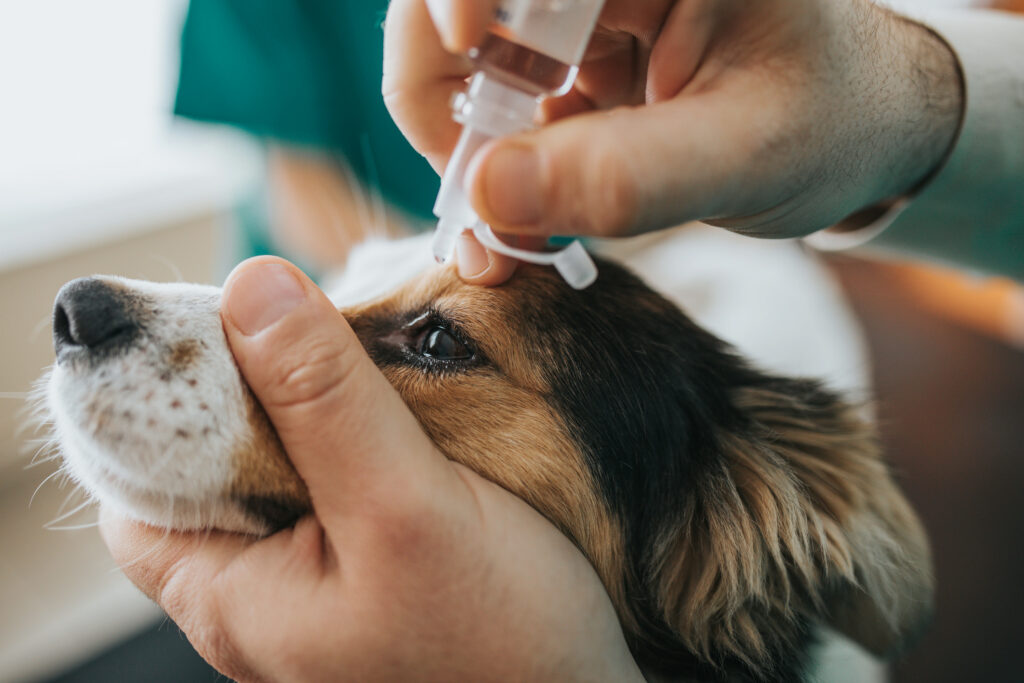
The best way to prevent eye discharge is to limit your dog’s risk of foreign materials, irritants, and injuries that can affect the eye. Supervise your dog during play, avoid letting your dog hang their head out the window while you are driving, and limit irritants (such as cigarette smoke and air fresheners) in your home.
In some cases, eye discharge is associated with infectious disease. Ensure that your dog is up to date with all vaccines recommended by your veterinarian, because vaccines can help prevent common infectious diseases.
Finally, be aware that some breeds are more prone to eye issues than others. If your dog belongs to a brachycephalic (squished face) breed, like a Pug or Bulldog, your dog may be more prone to eye issues than other breeds. Talk to your veterinarian about your dog’s unique risk factors for eye disease, and your veterinarian can help you figure out how to best address these concerns proactively.

